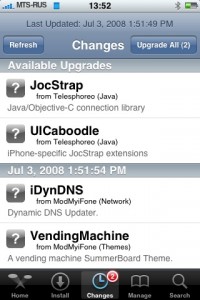News tagged ‘new version’
WinPwn 2.5 screenshots
WinPwn 2.5 will be released soon. The developer posted a screenshot of the new version's look:
Related posts:
Firmware 2.1 beta2 is out

Just a week after the first iPhone 2.1 beta seed, Apple has released another 2.1 firmware release to developers. The new version appears to include several bug fixes.
"This is the second beta of the iPhone SDK targeting iPhone OS 2.1, including bug fixes to iPhone OS as well as an early implementation of the Apple Push Notification Service API. This API is not yet integrated with a live push server."
Related posts:
New version of iTunes is 7.7.1
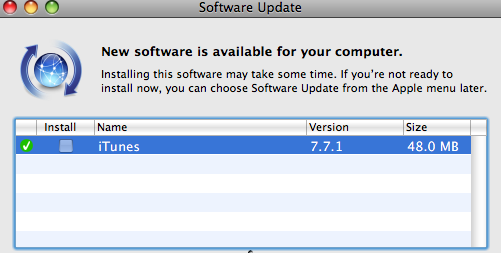
No direct download link yet. Just run iTunes and hit updates. The update includes "fixes to improve stability and performance".
Use iTunes 7.7 to sync music, video, and more with iPhone 3G, and download applications from the iTunes Store exclusively designed for iPhone and iPod touch with software version 2.0 or later. Also use the new Remote application for iPhone or iPod touch to control iTunes playback from anywhere in your home — a free download from the App Store.
iTunes 7.7.1 includes fixes to improve stability and performance.
WinPwn 2.5 soon
Developer of (curent version is ), IPhone unlocking and jailbreaking tool for Windows, announced today, that new version 2.5 will be released soon. Not much new features, mostely bugfixes.
"New WinPwn is being developed which will be a lot easier to use and should help a lot of people having issues."
NES emulator 2.0.3
The new version of the popular for the iPhone and iPod touch now includes accelerometer control for all games. The implementation is very simple: A tilt is equivalent to controlling input in that direction. This means that tilt control can be used in any game loaded into the emulator, but also that some of the controls are pretty much balls. Also, this app does not live in the official app store. NES.app 2.3.0 with tilt control is available now in Cydia.
As seen in the video, controlling Mario is fairly natural, though quick turns and exact jumps are difficult to execute (playing Mario with the stock controls is often worse, though). Bomberman sort of works, but in that case—and many others—the old touch control overlay is much easier. Obviously none of these games were designed with tilt control in mind, but a surprising number are at least playable.
via gizmodo
WinPwn updated to 2.0.0.3

New version 2.0.0.3 of released.
2.0.0.3 fixes the Ipwner crash problem and 16xx errors. It will also fix the iPod ipswBuilder failure bug.
Notes:
- Support for WinXP and Vista 32/64bit. Note Windows 2003/2008 server (Yes SERVER) are not supported neither is Windows 95 or Windows 3.11
- You MUST do a full uninstall of winpwn before installing the new version
- Make sure you have the latest version of iTunes ( Currently 7.7)
- WinPwn uses 300MB of ram at peak due to the ipsw being extracted in memory
- You must first click browse and load an IPSW to use WinPwn (i thought this was clear)
- For 2.0 only the *5A347_Restore.ipsw files are valid. The 345 image will not work
- If you see Failed to load image catalog/payload catalog, this is fine and won't cause problems
- If you already have service with AT&T do not activate or install Youtube Fix
Fixes:
- Cydia/XP/Writing root FS bug.
- Failed to remove ipsw directory after a ipswBuild failure.
- iPwner now only accepts custom ipsws.
- Remove 345 ipsw support. WinPwn only supports 347 2.0 ipsw's.
- Various other fixes.
Download 2.0.0.3:
 Leave a comment, read comments [1]
Leave a comment, read comments [1]
WinPwn 2.0 released
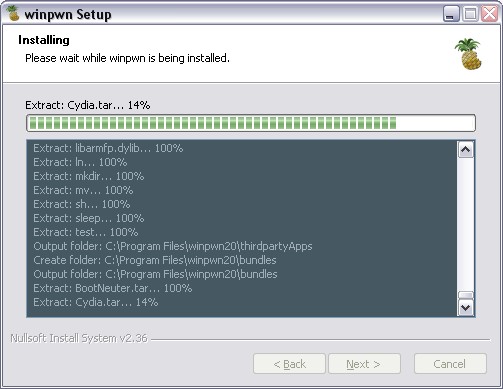
You can download it from or .
Featues:
- Support for both 1.1.4 and 2.0
- Custom Image Support
- Custom Payload Support
- 3g iPhone support
How to:
- First create a custom IPSW using the IPSW Builder (original is ).
- Click "Ipwner" and browse for the custom IPSW that you just created. This will pwn itunes and allow you to flash
- Custom IPSW files via DFU mode
- Once you have pwned Itunes, put your phone into DFU mode. If you don't know how to do this click .
- Once you are in DFU mode Itunes will pop up and then you can hold shift and click restore and browse to your custom IPSW file.
Important Notes
Remove Winpwn 1.0 completely if you have it installed. Installing over the top of WinPwn 1.0 will cause problems.
Make sure you have the latest version of iTunes ( Currently 7.7)
If you already have service with AT&T do not activate or install Youtube Fix
UPDATE: there is a new version avaliable:
 Leave a comment, read comments [1]
Leave a comment, read comments [1]
Вышла новая IPhone SDK

New IPhone SDK (build 9M2199a) is avaliable. Download . It's about 1.2 Gb.
IPhone web-based voice control from AT&T
AT&T has developed a software trick that will recognize voice commands without the need for specialized voice recognition software. It is based on a new version of AT&T's WATSON speech recognition engine.
As long as the software used to access Speech Mashups obeys certain web standards, particularly an AJAX framework and JavaScript, the technology can capture voice commands, interpret them at a remote server, and send them back to the device in a language a website or program can understand -- all without installing a dedicated app or plugin.
In a prototype mobile version of the YellowPages website, AT&T in a research video shows an iPhone user entering the business name and location into text fields on the page just by speaking them at the appropriate times. While typing would work in such a case, the company claims that voicing the information is faster and more convenient.
via appleinsider
xpwn 0.3 sources are now up
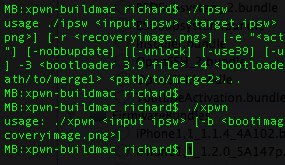
The for xpwn 0.3, the firmware 2.0 version of our cross-platform jailbreaking library/command-line utility have been pushed onto . DevTeam tested it on Linux, Windows XP, and Windows Vista for both the iPhone 2G and iPhone 3G thus far, but since it uses the same FirmwareBundles files as PwnageTool, and we know those work for the iPod touch, there ought not be any problems.
Being a suite of command-line utilities, this release is meant primarily for developers. While you can certainly jailbreak (both 3G and first-gen) and unlock (first-gen) with it, it's not really something you want to try without reading the lengthy, detailed README. If you don't have the patience to do that, this release is not for you.
For users this news mean that quite soon there will be a new version of winpwn, supporting 2.0.
Safari benchmark - 2.0 is faster than 1.1.4
There is not much defference between Safari 1.1.4 and 2.0. But Under the hood, MobileSafari 2.0's performance is hugely improved over 1.1.4. Everything related to web surfing feels faster, web pages consistently load faster on 2.0, both via Wi-Fi and EDGE. This has nothing to do with the new iPhone 3G hardware — this is about dramatic performance improvements on original iPhones upgraded to the 2.0 OS.
Using MobileSafari simply feels faster, especially with web applications. Feel is by nature subjective, but JavaScript benchmarks back this up.
In August last year, to compare the iPhone's processing power and JavaScript interpreter against Safari 3 running on a Mac with a 1.83 GHz Core Duo. At that time, the current version of the iPhone OS was 1.0.1. Here are the results of those same benchmarks on original iPhones running the 1.1.4 and new 2.0 OS versions, with Hockenberry’s 1.0.1 results included for comparison:
| Test | 1.0.1 | 1.1.4 | 2.0 | Vs. 1.0.1 / 1.1.4 |
|---|---|---|---|---|
| 100,000 iterations | 3.209 | 1.096 | 0.145 | 22× / 8× |
| 10,000 divisions | 0.413 | 0.181 | 0.029 | 14× / 6× |
| 10,000 sin(x) calls | 0.709 | 0.373 | 0.140 | 5× / 3× |
| 10,000 string allocations | 0.777 | 0.434 | 0.133 | 6× / 3× |
| 10,000 function calls | 0.904 | 0.595 | 0.115 | 8× / 5× |
The last column shows how many times faster the 2.0 version of MobileSafari was versus 1.0.1 and 1.1.4. The same results, charted (smaller bars are faster) can be viewed above.
The results are obvious. WebKit JavaScript performance has improved steadily and significantly in just one year, with a huge jump between 1.1.4 and the new 2.0.0. In side-by-side page loading tests between two original iPhones running 1.1.4 and 2.0.0, the new version consistently finished at least a few seconds faster.
For all the hubbub regarding the new App Store, most “iPhone software” runs in the web browser. But improvements in WebKit performance often help native iPhone app performance, too — a slew of my favorite native iPhone apps have built-in WebKit browsers (e.g., NetNewsWire, Twitterrific, Instapaper, and Cocktails). When WebKit performance improves, any app that uses WebKit improves, and WebKit improved a lot between iPhone 1.1.4 and 2.0.0.
via daringfireball.net
New version of JocStrap and UICaboodle is avaliable
These two libraries that are needed for Java on IPhone were updated recently. Downloads are avaliable through Cydia Installer.
Jocstrap is a bridge between Java and Objective-C. UICaboodle is a JocStrap extenstion for the IPhone. Both are needed to write Java applications for IPhone.
New version of JamVM is avaliable
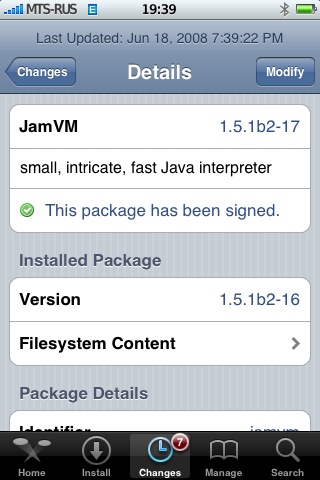
JamVM - Java Virtual Mashine for IPhone, has been updated. New version 1.5.1b2-17 is avaliable through Cydia Installer.
